Abstract
A deployable reflector antenna (DR-A) is a structure that can be stored in a large-diameter Synthetic Aperture Radar (SAR) antenna and be mounted onto a launch vehicle. Considering the performance of the launch vehicle, it is necessary to develop a lightweight, high-performance antenna structure. The solid-type deployable reflector antenna is composed of a number of unit main reflectors. To reduce the weight of the antenna, a lightweight main reflector must be developed. In this paper, following “Development of Deployable Reflector Antenna for the SAR Satellite (Part 1)”, the manufacturing and qualification of the main reflector using honeycomb sandwich composites are described. Four types of composite main reflectors were manufactured with variables in the manufacturing process. The manufacturing variables include the curing process of the structure, the application of an adhesive film between the sheet and the core, and the venting path inside of the sandwich core. After manufacturing the main reflector, we performed weight measurements, non-destructive testing (NDT), surface error measurement using a Coordinate Measurement Machine (CMM), and modal testing for each type of composite main reflector. Through the research and development process, we found that a perforated hole is necessary when excluding the adhesive film during bonding of an aramid core and a CFRP sheet, and a lightweight composite reflector could be developed through this process. We selected the main reflector with the best performance and developed a composite main reflector that can be applied to satellites.
1. Introduction
Satellites equipped with Synthetic Aperture Radar (SAR) use a technique that creates images based on radio waves reflected from the ground, enabling them to perform reconnaissance missions more efficiently than Electro-Optical/Infrared (EO/IR) satellites. SAR satellites must be stored in the limited volume of launch vehicles, and the performance of both the launch and the satellite mission operations must be considered. Given these weight and performance requirements, reflector antennas with deployable structures are being developed and deployed in advanced countries, as well [1,2,3,4,5,6,7,8,9,10].
Deployable reflector antennas must be designed to ensure thermal and structural stability, taking into account both the launch and orbital environments. The main reflector, a key component that accounts for a large proportion of the antenna’s total weight, consists of 24 individual reflectors and significantly influences the satellite’s performance. The initial design of the composite main reflector was confirmed based on the design and analysis of the unit reflectors and performance analysis of the system model, which includes all the antenna components [11,12,13,14,15].
In this paper, in order to secure a method for reducing the weight of a satellite, a case study of a composite main reflector was conducted to design and develop it, and a study was conducted to develop a composite main reflector that is lighter and that can secure lightweight performance through development.
Composite structures exhibit varying performances depending on the manufacturing process, making the selection of process variables and performance verification essential for developing composite structures suitable for deployable reflector antennas. In this study, (1) four types of main reflectors were manufactured using Carbon Fiber Reinforced Plastic (CFRP) and honeycomb sandwich panels, each corresponding to different manufacturing methods, (2) the performance of each structure was evaluated based on weight, mass properties, dynamic stiffness, and surface shape accuracy, and (3) a composite reflector suitable for SAR antennas was developed.
2. Manufacturing the Composite Main Reflector
2.1. Deployable Reflector Antenna Requirements Derivation
The composite main reflector applied to the SAR antenna was designed to meet the weight and stiffness requirements, as shown in Table 1. These requirements were determined based on the satellite’s launch conditions and orbital operation conditions.

Table 1.
Requirements for antenna.
The antenna’s dimension requirements were defined considering the transmit–receive performance of the reconnaissance satellite antenna. When assuming the weight of the entire satellite would be between 500 and 1000 kg, the weight of the antenna, excluding the satellite body, was estimated to be in the 100 kg class.
Satellites are launched using launch vehicles to carry out their missions. To prevent resonance between the launch vehicle and the satellite during the launch process, the stiffness of the antenna was selected to be 33 Hz or higher in the stowed condition, considering the loading requirements of certain launch vehicles.
In order to perform reconnaissance missions in Spotlight mode, which involves repeatedly photographing the target area during satellite orbital operations, the satellite performs agile attitude control maneuvers to focus on the reconnaissance area. The stiffness of the antenna was selected to be 2.5 Hz or higher in the deployed condition, considering the stabilization time for the vibration behavior of the antenna reflector surface that occurs after attitude control [16].
2.2. Initial Design of the Composite Main Reflector
In order to initially design the composite main reflector, the laminate pattern and the material properties were selected as design variables, and an analysis of the composite main reflector’s design was performed.
Through a relative comparison of the stiffness according to the laminate pattern of the main reflector, the laminate pattern of was selected, and as a result of comparing the weight and stiffness according to the honeycomb core design as shown at Figure 1, the model with the low-density honeycomb core was superior to the model with the high-density core, and it was calculated that a weight reduction of approximately 8.8% was possible [17].
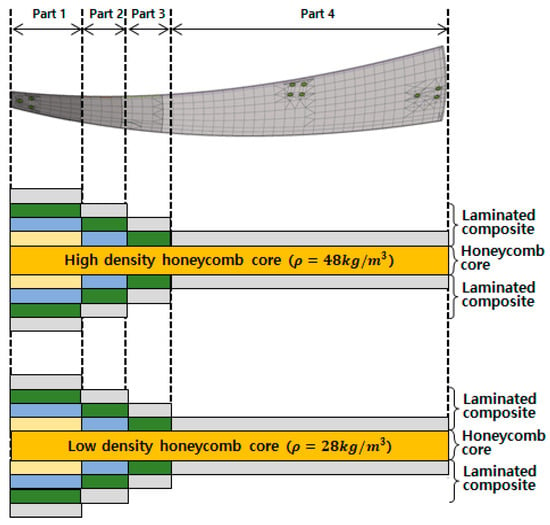
Figure 1.
Design of composite main reflector under density of honeycomb core.
The results of the analysis of the entire model for the deployable reflector antenna, including the main reflector with the low-density honeycomb core, are shown in Table 2 and Figure 2. As a result of comparing the structural performance according to the design variables, the main reflector with the low-density core showed relatively superior weight and rigidity performance, and the initial design of the composite main reflector was derived by selecting the lamination method and the applicable materials through the analysis process [18].

Table 2.
Analysis results of the initial design of the main reflector and the antenna.
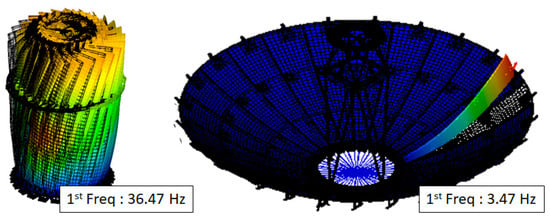
Figure 2.
Modal analysis results for deployable reflector antenna (low-density core).
2.3. Verification of Manufacturing Process Variables
As shown in Figure 3, the composite main reflector of the deployable reflector antenna is manufactured using prepreg (carbon fiber and resin-impregnated sheet) and an aramid material honeycomb core, and it is laminated through a hand-layup method in which materials are stacked on a metallic mold that is designed and manufactured in consideration of a reflective surface.
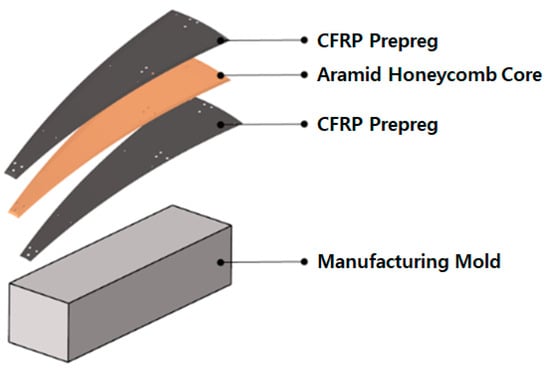
Figure 3.
Stacking of composite main reflector.
Due to the manufacturing characteristics of composite structures, there are process variables, such as the workability, the application of the adhesive film between the layers, and the curing method. In this study, four types of composite main reflectors were manufactured according to these process variables, as shown in Table 3.

Table 3.
Finite element analysis results of the main reflector and the antenna.
The first variable for the manufacturing process was considered to be the curing method. The composite main reflector is a sandwich composite with an aramid core. Because the aramid core has a lower compressive strength in the thickness direction than the aluminium core, deformation may occur in the thickness direction of the honeycomb core when high curing pressure is applied.
Considering this effect, if the sandwich composite is cured in low-pressure conditions, the fiber volume fraction is low, which may result in low structural performance of sandwich composites.
In addition, because the main reflector is manufactured with 2 to 8 numbers of ply, pin-holes may occur due to resin flow if the curing pressure is not high enough.
For Case 1, the reflector face was laminated in the metallic mold, and the first curing was performed under high pressure (40 psi, 0.276 MPa), and then the honeycomb core and the outer surface were laminated. Then, the second curing was performed under low pressure (10 psi, 0.068 MPa) using the co-bonding method.
For Cases 2~4, a co-curing process was applied in which the reflective surface, the honeycomb core, and the outer surface were all laminated on the mold and then cured at once under low pressure (10 psi, 0.068 MPa).
The second variable for the manufacturing process was considered to be the application of the adhesive film. Generally, when manufacturing a sandwich composite by applying an aluminium honeycomb core, an adhesive film should be applied to the contact surface for adhesion between the honeycomb core and the carbon fiber sheet. However, when applying an aramid core, the core and the sheet can be bonded through the resin impregnated in the prepreg, so, in Cases 3 and 4, the adhesive film was excluded, and the production was performed using the co-curing process [19].
In the case of the initial design of the main reflector described in Section 2.1, the area where the adhesive film is applied is large, so the weight of the adhesive film per unit of main reflectors is expected to be approximately 100 g, and if the adhesive film for all 24 main reflectors is excluded, the weight of approximately 2.4 kg can be reduced.
The third variable for the manufacturing process was considered to be the perforation of the honeycomb core wall (perforating the hole). Unlike the general sandwich structure, the composite reflector is an edge-closed-type sandwich composite structure in which the outer surface is entirely composed of CFRP prepreg.
If the sandwich composite is manufactured without the adhesive film using un-perforated honeycomb core, gas may remain inside of the core cell, as shown in Figure 4, and some of the gas inside of the cell may not be removed during the vacuum bagging process. The composite reflector is formed at a low curing pressure (0~10 psi) due to the strength characteristics of the aramid core. In this case, the pressure of the gas inside of the core cell increases under high-temperature curing conditions (170~180 °C), and if the internal pressure is higher than the curing pressure applied from outside of the structure, the bonding between the core and the sheet may not proceed smoothly (Figure 5).

Figure 4.
Pressure distribution during curing without venting path.
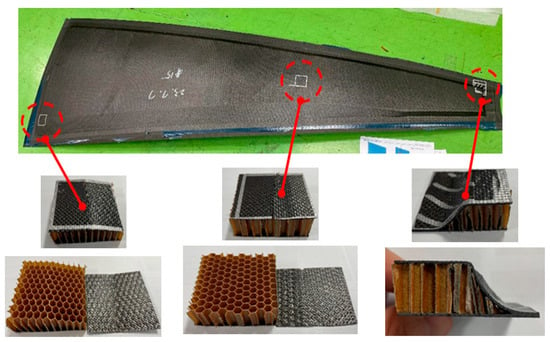
Figure 5.
De-bonding between face sheet (CFRP) and honeycomb core when curing without venting path.
Therefore, in this study, perforation holes were applied on the honeycomb core wall surface for the composite reflector in Cases 3 and 4, as shown in Figure 6 and Figure 7. Additionally, a hole capable of forming a venting path was machined into the outer surface of the main reflector and a co-curing process was performed. It was confirmed that no problems occurred in the production of an edge-closed-type sandwich composite including a venting path [20].

Figure 6.
Pressure distribution during curing with venting path.

Figure 7.
Perforated holes in aramid honeycomb core.
The final variable for the manufacturing process was considered to be the additional layup process to laminate additional reinforcement to the fastening portion of the composite main reflector. As shown in Figure 8, the deployable reflector antenna includes deployable structures at the top, middle, and bottom of the antenna, and the deployable structures are fastened through the fastening interface of the main reflector. Accordingly, when a load, such as a launch load, is applied to the antenna structure in the stowed state, stress concentration may occur at the interface, and the interface stiffness with the lower deployable structure may also affect the stiffness of the antenna when deployed. Therefore, Case 4 was manufactured by locally performing an additional 2-ply lamination.
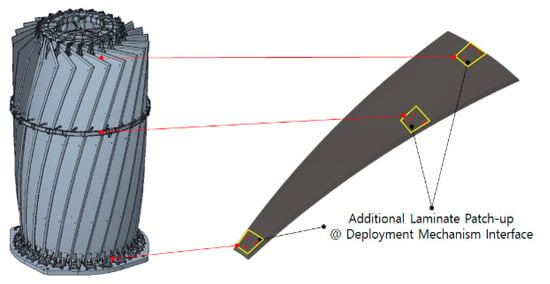
Figure 8.
Additional laminate patch-up at the interface section of the main reflector.
2.4. Manufacturing the Composite Reflector
The manufacturing process for the composite reflector was carried out by laminating CFRP prepreg through a hand-layup process and autoclave curing, which is the same as the general composite manufacturing process.
Based on the initial design plan and considering the structural performance, four types of reflectors were manufactured according to process variables.
(1) A co-bonding process in which the reflective surface is first cured at high pressure (40 psi) to minimize pin-holes on the reflective surface and then the adhesive film–honeycomb core–adhesive film–outer surface is laminated in the order of the molded reflective surface. Then, the second curing (10 psi) is performed
(2) A co-curing process in which the reflective surface–adhesive film–honeycomb core–adhesive film–outer surface is laminated, and then the curing is performed at once at low pressure (10 psi)
(3) A co-curing process in which the reflective surface–honeycomb core (with perforated holes)–outer surface excluding the adhesive film and the venting path are secured and the curing is performed at once at low pressure (10 psi)
(4) A co-curing process involving the reflective surface–honeycomb core (with perforated holes)–outer surface, excluding the adhesive film. Then, the fastening interface part is additionally reinforced and laminated, the venting path is secured, and curing is performed at once at low pressure (10 psi)
Metallic molds are manufactured considering the precise surface error of the main reflector using Invar 36 material with little thermal deformation.
As shown in Figure 9, the prepreg and honeycomb core were machined to fit the shape of the main reflector. Then, using a Lay-up Location Projector according to the lamination angle and the order, the prepreg was laminated using a hand-layup process. The laminated structure was cured using autoclave equipment that can apply temperature and pressure.
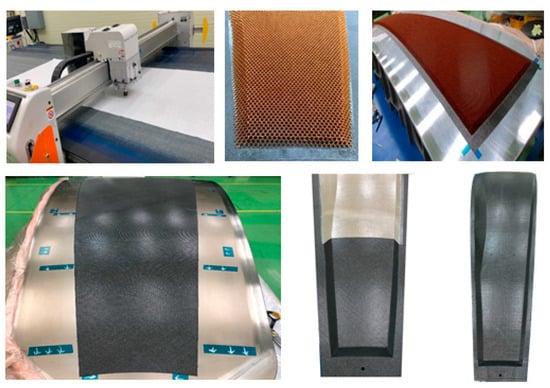
Figure 9.
Manufacturing of sandwich composite main reflector.
The main reflector after curing was checked for defects in the product through visual inspection and non-destructive testing (NDT; details regarding NDT are described in Section 3.1). Considering the interface of the deployable structure of the deployable reflector antenna attached to the main reflector, a hole was machined, and resin potting was performed to insert a metal insert.
3. Verification of the Composite Main Reflector
3.1. Verification of the Manufacturing of the Composite Main Reflector
In this paper, we manufactured a reflector with four process variables and fabricated and verified the performance of a total of twelve reflectors, with three for each case. In this paper, only the representative verification results for each case are described.
As a first verification, the weights of four types of composite reflectors manufactured according to the process variables defined in Table 3 were measured. The weight of the manufactured main reflector was calculated to be lower than that of the main reflector estimated in the initial design stage. This is because the weight per area of the actual supplied prepreg was lower than that predicted in the initial design stage. The weights of Case 3 and 4, excluding the adhesive film, were lower than Case 1 and 2.
In the case of Case 1, the reflector surface of the main reflector was first cured at a curing pressure of 40 psi, and it was manufactured without voids or pin-holes on the reflector surface. However, in the case of Case 2, the entire main reflector was manufactured at a curing pressure of 10 psi and through a co-curing process, and pin-holes were inspected on the reflector surface as shown in Figure 10. The pin-holes are very small holes with a diameter of less than 0.01 mm, and they were caused by low molding pressure. Because they are not considered to affect the electrical performance of the reflector antenna, they were not judged to be manufacturing defects.
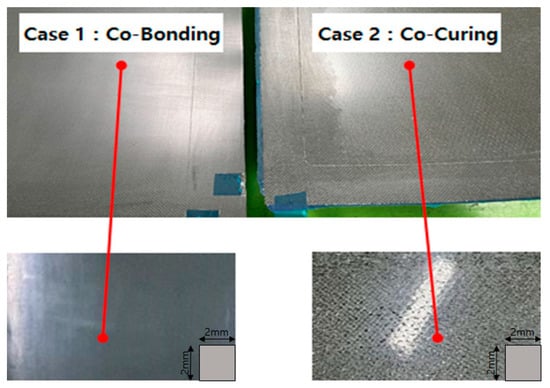
Figure 10.
Comparison of the surface of the main reflector based on curing conditions.
Non-destructive testing (NDT) was performed using TTU (Through-Transmission Ultrasonic)-type C-Scan equipment with a frequency of 0.5 to 5 MHz. A reference specimen was produced to establish a standard for non-destructive testing, and the part measured below 12 dB based on the fact that the sound part of the reference specimen is indicated as a sound part in green or blue in the C-Scan results and the part measured above 12 dB is indicated as a defective part in red in the C-Scan results, allowing for the determination of defects.
The results of the non-destructive test are shown in Figure 11. In the case of the main reflectors in Cases 1 and 2 that applied the adhesive film, only a difference in the measurement signal (blue, green zone) according to the lamination pattern was observed, and no separate defects were detected. In the case of the main reflectors in Cases 3 and 4 that did not use the adhesive film, a defect signal (red zone) was detected in some edge areas, but the defect size was very small (less than 1 inch), so it was determined that there was no structural abnormality.

Figure 11.
Results of NDT for main reflectors.
3.2. Analysis of the Surface Error of the Composite Main Reflector
The composite main reflector that constitutes the reflector surface of the deployable reflector antenna must be manufactured by precisely simulating the shape of the reflector surface design considering the electrical performance of the antenna. To this end, the surface error of the composite main reflector surface that was finally manufactured and processed was measured and analyzed.
In order to confirm the dimensional stability of the curved surface of the composite main reflector’s surface, the measurement reference coordinates were selected at regular intervals for the entire main reflector, and the dimensions of the product were measured using a CMM (Coordinate Measuring Machine).
When the main reflector is installed in a shape similar to the orbital environment and measured with a CMM, it was confirmed that the main reflector sagged due to the influence of gravity, resulting in a measurement error of more than 5 mm.
Because the side of the main reflector is designed to be installed horizontally to the ground, a gravity compensation device was used to install the main reflector vertically, as shown in Figure 12. And, 75 points were measured for each case of the manufactured main reflector to analyze the surface error.
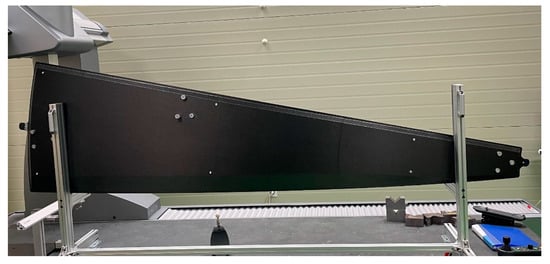
Figure 12.
Coordinate measurement configuration considering gravity.
3.3. Verification of the Performance of the Composite Main Reflector
In order to verify the performance of the reflector based on the manufacturing process, a modal test of a single reflector was performed. The modal test was performed using accelerometer-type Dewetron equipment. After attaching an accelerometer to the end of the reflector, the reflector was excited using an impact hammer to measure the stiffness of each of the four types of reflectors when in deployed conditions. In order to simulate the deployment shape of the actual antenna during the test, a deployment structure was attached to the top, middle, and bottom of the antenna, as shown on the left side of Figure 13, and the test was performed at the same deployment angle as the actual operating conditions.

Figure 13.
Test configuration and result of modal test on reflector.
The test results are shown on the right side of Figure 13. All of the manufactured reflectors satisfied the stiffness requirement (2.5 Hz or more) when the antenna was deployed. But, the first natural frequency was measured to be relatively high because the weight of the composite reflectors in Cases 3 and 4 excluding the adhesive film was lighter than the others. In the case of the reflector in Case 4, which was additionally laminated at the fastening interface, the weight increased slightly compared to Case 3, but as the number of laminates at the location supporting the reflector under the deployment condition increased, the stiffness of the restraint increased, and the stiffness when the reflector was deployed also tended to increase.
3.4. Selection of Composite Main Reflector for Deployable Reflector Antenna Application
The performance verification results of the main reflector according to the manufacturing process are shown in Table 4.

Table 4.
Qualification results of the composite main reflector.
All manufactured composite main reflectors satisfied the antenna design requirements. The composite main reflector manufactured under a co-curing process has more pin-holes than the co-bonding process, but it was judged that this would not have a significant effect on the antenna’s RF performance. It was also confirmed that the two processes did not have a significant effect on the mechanical performance of the main reflector.
It was estimated that de-bonding occurred after curing due to the internal pressure of the structure caused by the gas remaining inside of the core when the adhesive film was excluded during bonding between the CFRP sheet and the aramid honeycomb core. Accordingly, for the main reflectors in Cases 3 and 4 excluding the adhesive film, perforations were processed on the core wall to add a venting path inside of the structure, and it was confirmed that there was no problem with edge-closed-type composite manufacturing. In the case of the main reflectors in Cases 3 and 4, a weight reduction of approximately 5% was possible compared to the main reflectors in Cases 1 and 2 by excluding the adhesive film. And, it was confirmed that a weight reduction of approximately 2 kg was possible for the 24 main reflectors of the antenna. In the case of the main reflector in Case 4, the weight increased slightly compared to Case 3 due to the application of an additional lamination process, but it was confirmed that the rigidity also increased during deployment. In the case of deployable reflector antennas for satellites, because agile maneuvering in orbital operation conditions is important, the rigidity of the main reflector during deployment was considered the most important performance.
Through this study, Case 4’s main reflector, which enables additional weight reduction of the composite main reflector and secures high rigidity during deployment, was selected as the single main reflector of the deployable reflector antenna.
4. Conclusions
In order to develop a composite main reflector, which is a core component of a satellite deployable reflector antenna, the structural performance according to the laminated design and material properties of the composite main reflector was analyzed to design the main reflector. Afterwards, based on the designed main reflector, the manufacturing method, the application of the adhesive film, and the venting path inside of the sandwich were selected as design variables during the manufacturing process, and four types of composite main reflectors were manufactured. For each main reflector, weight measurement, non-destructive inspection, surface error measurement, and stiffness measurement during deployment were performed. Through the performance analysis of the composite main reflector according to the manufacturing variables, a process that can achieve additional weight reduction and secure high stiffness during deployment was selected. Through this study, the design, analysis, manufacturing, and verification of the composite main reflector were performed, and a composite main reflector that can be applied to a deployable reflector antenna was developed through the process.
In the future, we plan to conduct environmental tests (e.g., antenna performance evaluation for vibration and thermal loads) to verify the structural performance of the developed deployable reflector antenna, as well as deployment and RF characteristic verification to verify the antenna’s functionality.
Author Contributions
Conceptualization, Y.-J.Y.; methodology, D.-G.K.; software, D.-G.K. and H.-G.K.; validation, D.-G.K. and H.-G.K.; formal analysis, D.-G.K.; investigation, D.-G.K.; resources, Y.-J.Y.; data curation, D.-G.K., D.-Y.K. and R.-H.D.; writing—original draft preparation, D.-G.K.; writing—review and editing, K.-R.K.; visualization, D.-G.K. and H.-G.K.; supervision, K.-R.K.; project administration K.-R.K.; funding acquisition, K.-R.K. All authors have read and agreed to the published version of the manuscript.
Funding
This study was conducted with support from the Korea Research Institute for defense Technology planning and advancement and the Defense Acquisition Program Administration in 2021 (20-207-B00-011-001).
Institutional Review Board Statement
Not applicable.
Informed Consent Statement
Not applicable.
Data Availability Statement
All data are in the paper; there are no additional data.
Conflicts of Interest
The authors declare no conflicts of interest.
References
- Paulis, F.; Giuliomaria, D.D.; Fina, A.; Amici, M.; Mannocchi, G.; Carlofelice, A.D.; Fiaschetti, A.; Tognolatti, P.; Orlandi, A. Highly Integrated Wideband Transmit/Receive Module for X-Band SAR Applications. Appl. Sci. 2023, 13, 801. [Google Scholar] [CrossRef]
- Nasirzadehdizaji, R.; Sanli, F.B.; Abdikan, S.; Cakir, Z.; Sekertekin, A.; Ustuner, M. Sensitivity Analysis of Multi-Temporal Sentinel-1 SAR Parameters to Crop Height and Canopy Coverage. Appl. Sci. 2019, 9, 655. [Google Scholar] [CrossRef]
- Xia, Z.; Jin, S.; Yue, F.; Yang, J.; Zhang, Q.; Zhao, Z.; Zhang, C.; Gao, W.; Zhang, T.; Zhang, Y.; et al. A Novel Space-Borne High-Resolution SAR System with the Non-Uniform Hybrid Sampling Technology for Space Targets Imaging. Appl. Sci. 2022, 12, 4848. [Google Scholar] [CrossRef]
- Zhao, H.; Hao, Z.; Liu, W.; Ding, J.; Sun, Y.; Zhang, Q.; Liu, Y. The shock environment prediction of satellite in the process of satellite-rocket separation. Acta Astronaut. 2019, 159, 112–122. [Google Scholar] [CrossRef]
- Rizzo, F.; Franco, A.; Bonati, A.; Maddaloni, G.; Caterino, N.; Occhiuzzi, A. Predictive analyses for aerodynamic investigation of curtain walls. Structures 2021, 29, 1059–1077. [Google Scholar] [CrossRef]
- Maheshwaraa, U.; Bourell, D.; Conner, S.C. Design and Freeform Fabrication of Deployable Structure with Lattice Skins. Rapid Prototyp. J. 2007, 13, 213–225. [Google Scholar] [CrossRef]
- Footdale, J.N.; Jeremy, B. Design and deployment testing of the multi-arm radial composite (MARCO) reflector antenna. In Proceedings of the 3rd AIAA Spacecraft Structures Conference, San Diego, CA, USA, 4–8 January 2016. [Google Scholar]
- Petrie, G. Current & Future Spaceborne SAR Systems. In Proceedings of the International Scientific & Technical Conference, Porec, Croatia, 15–18 September 2008. [Google Scholar]
- Manfred, S.; Reiner, B. Development Summary and Test Results of a 3 Meter Unfurlable CFRP Skin Antenna Reflector. In Proceedings of the 10th European Space Mechanisms and Tribology Symposium, San Sebastian, Spain, 24–26 September 2003; pp. 145–151. [Google Scholar]
- Alberto, M.; Cicco, L.D.; Riccardo, R.; Davide, S. Large reflector technologies at TAS-1. In Proceedings of the 3rd International Conference Advanced Lightweight Structures and Reflector Antennas, Ahmedabad, India, 19–22 December 2018. [Google Scholar]
- JAXA. Epsilon Launch Vehicle User’s Manual; JAXA: Tokyo, Japan, 2016.
- ILS. Proton Launch System Mission Planner’s Guide; ILS: Moriya, Japan, 2009. [Google Scholar]
- Arianespace. Vega C User’s Manual; Arianespace: Paris, France, 2018. [Google Scholar]
- Arianespace. Ariane 6 User’s Manual; Arianespace: Paris, France, 2021. [Google Scholar]
- Kim, T.-H.; Kim, D.-Y.; Suh, J.-E.; Han, J.-H.; Lee, J.-E.; Jung, H.-Y. Vibration Analysis of SAR Antenna Reflectors During Satellite Maneuver. Korean Soc. Aeronaut. Space Sci. 2020, 48, 225–231. [Google Scholar] [CrossRef]
- Alberto, M.; Prats-Iraola, P.; Younis, M.; Krieger, G.; Hajnsek, I.; Papathanassiou, K.P. A Tutorials on Synthetic Aperture Rader. IEEE Geosci. Remote Sens. Mag. 2013, 1, 6–43. [Google Scholar]
- Kim, D.-G.; Koo, R.-K.; Kim, H.-G.; Song, S.-C.; Kwon, S.-C.; Lim, J.-H.; Kim, Y.-B. Design and Analysis of Composite Reflector of High Stable Deployable Antenna for Satellite. Compos. Res. 2023, 36, 230–240. [Google Scholar]
- Kim, H.-G.; Kim, D.-G.; Do, R.-H.; Koo, K.-R.; Yu, Y.-J. Development of Deployable Reflector Antenna for the SAR-Satellite: Part 1. Design and Analysis of the Main Reflector Using Honeycomb Sandwich Composite Structure. Appl. Sci. 2024, 14, 1590. [Google Scholar] [CrossRef]
- Yuan, C.; Li, M.; Zhang, Z.; Gu, Y. Experimental Investigation on the Co-Cure Processing of Honeycomb Structure with Self-Adhesive Prepreg. Appl. Compos. Mater. 2008, 15, 47–59. [Google Scholar] [CrossRef]
- Epstein, G.; Ruth, S. Honeycomb Sandwich Structures: Vented versus Unvented Designs for Space Systems. Aerosp. Corp. 1993. Available online: https://www.semanticscholar.org/paper/Honeycomb-Sandwich-Structures%3A-Vented-Versus-for-Epstein-Ruth/68444f47cf9a53bbebbef002a5d8ec1465efc7b4 (accessed on 28 November 2024).
Disclaimer/Publisher’s Note: The statements, opinions and data contained in all publications are solely those of the individual author(s) and contributor(s) and not of MDPI and/or the editor(s). MDPI and/or the editor(s) disclaim responsibility for any injury to people or property resulting from any ideas, methods, instructions or products referred to in the content. |
© 2024 by the authors. Licensee MDPI, Basel, Switzerland. This article is an open access article distributed under the terms and conditions of the Creative Commons Attribution (CC BY) license (https://creativecommons.org/licenses/by/4.0/).